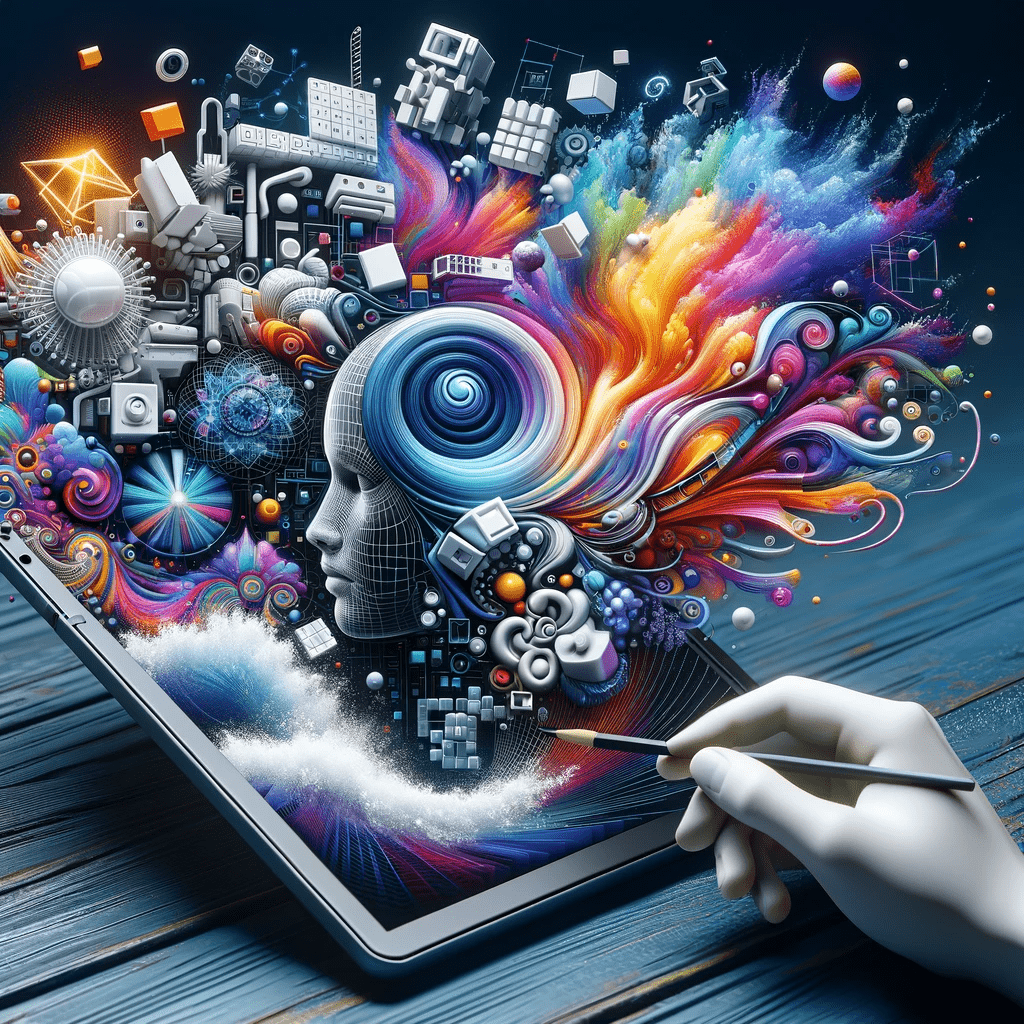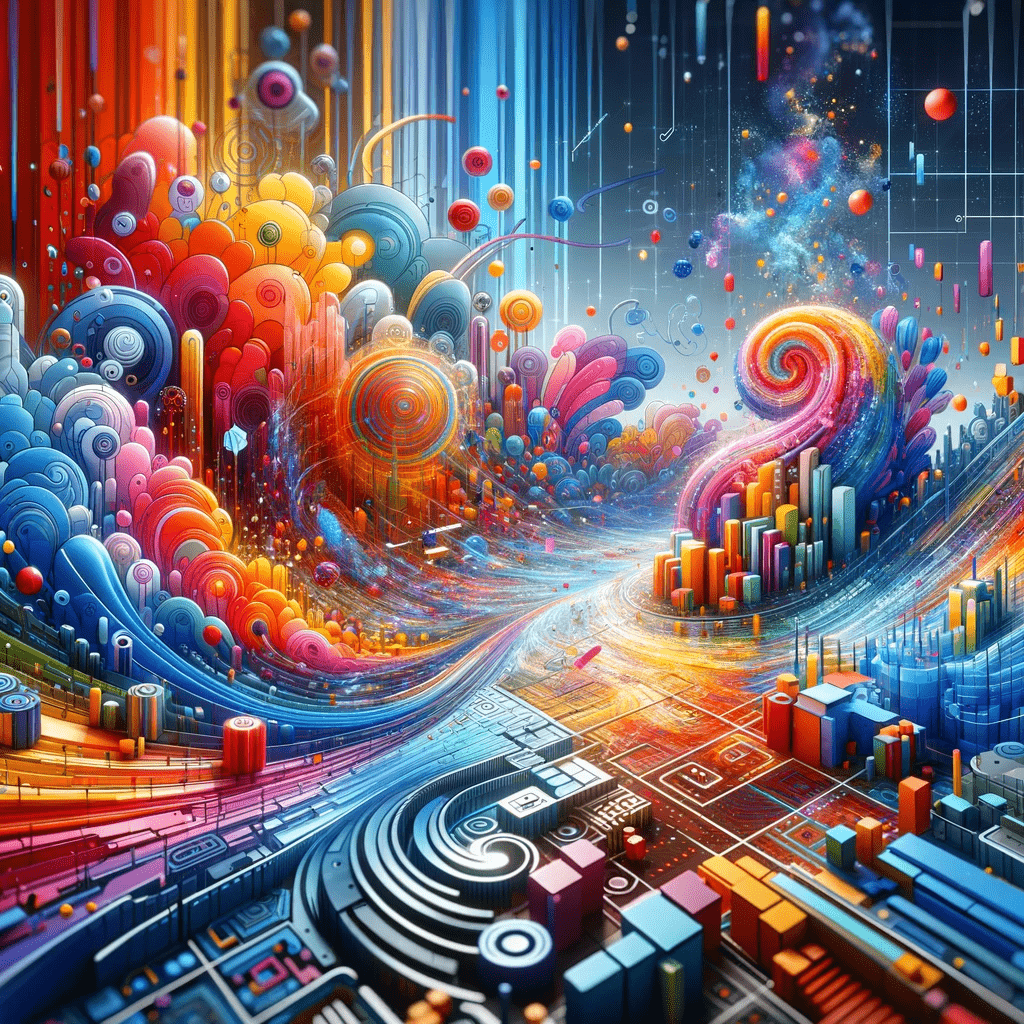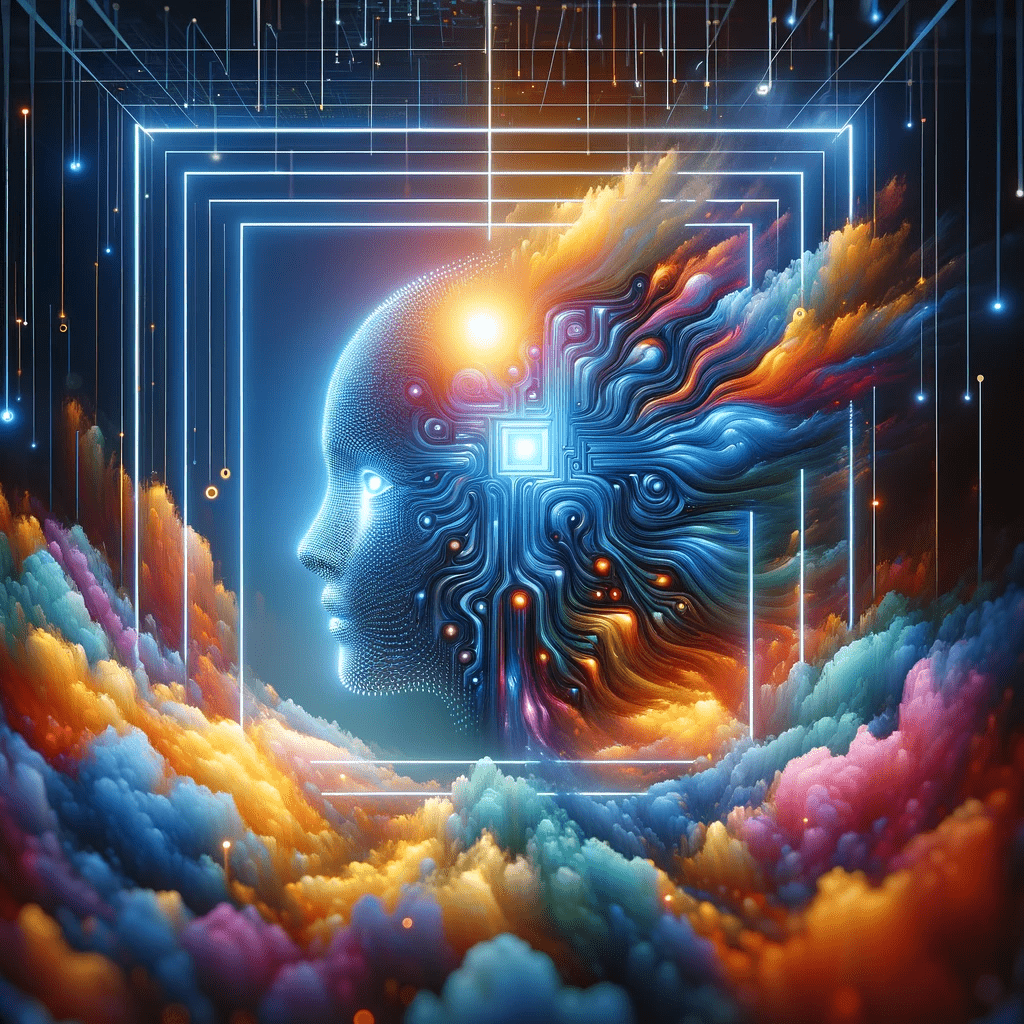Last Updated on January 8, 2024 10:14 am by Laszlo Szabo / NowadAIs | Published on January 8, 2024 by Laszlo Szabo / NowadAIs
Key Takeaways for Everything You Need to Know About Generative Artificial Intelligence:
- Generative AI in Content Creation: Utilizes machine learning algorithms to generate text, images, music, enhancing creativity and personalization in various applications.
- Data Collection and Training: Involves collecting diverse datasets and employing deep learning techniques for effective training of AI models.
- Applications Across Industries: From content marketing to graphic design, Generative AI is leveraged for creating engaging text and photorealistic images, revolutionizing these fields.
- Ethical and Legal Considerations: Raises concerns about misinformation, privacy, and intellectual property, necessitating responsible use and regulation.
- AI in Chatbots and Virtual Assistants: Enhances customer interaction through natural language processing, streamlining business processes.
- Impact on Job Market and Industry: While it may lead to job displacement in some areas, Generative AI also opens new avenues for employment and innovation.
What is Generative AI? A Quick Introduction
Have you ever wondered how chatbots or virtual assistants are able to interact with us in a human-like manner?
The answer lies in Generative AI.
Thistechnology allows machines to generate original content, making them more intelligent and natural. Now we will delve into the concept of Generative AI and its importance in today’s digital landscape.
The Starting Stone: Data Collection
Data collection is a crucial step in utilizing generative AI models to create synthetic data.
High-quality data is needed to train these models effectively. Collecting diverse and representative datasets ensures that the generative AI model can produce accurate and realistic synthetic data.
When gathering data, it is essential to consider the specific requirements of the AI model and the desired outcomes.
By leveraging the power of generative AI to create synthetic data, organizations can enhance their training datasets, improve algorithm performance, and address data collection or privacy concerns.
Training – Machine Learning of AI Models
Training is a crucial step in the development of generative AI models. Here are the steps involved:
- Data collection: Gather a diverse and representative dataset to train the model.
- Preprocessing: Clean and preprocess the data to remove noise and ensure consistency.
- Model selection: Choose an appropriate architecture, such as large language models or breakthrough language models, depending on the task.
- Training: Utilize a machine learning algorithm, like GPT (Generative Pretrained Transformer), to train the model on the dataset.
- Evaluation: Assess the model’s performance using metrics and compare against baseline results.
- Fine-tuning: Refine and optimize the model through iterative training on specific tasks or domains.
Pro-tip: Experiment with different training techniques and hyperparameters to improve model performance.
Prompting Generative AI Models
Prompting an LLM AI is the one of the most important tasks to get high quality results.
Generating new and engaging content using generative AI involves several steps:
- Understanding the task: Define the purpose of generating new content, whether it’s for storytelling, creating product descriptions, or generating blog posts.
- Data collection: Gather a large dataset of relevant and diverse examples to train the AI model on. This can include text, photorealistic images, or a combination of both.
- Model training: Train the generative AI model using deep learning techniques, allowing it to learn patterns and generate new content based on the input data.
- Evaluation and refinement: Evaluate the output generated by the AI model and refine it based on desired criteria such as coherence, relevance, and creativity.
The AI-generated content not only saved time and effort but also impressed clients with its quality and creativity.
Additionally, a graphic design company could utilized generative AI to generate photorealistic images, enabling them to produce stunning visuals for their marketing campaigns.
Benefits of Generative AI: Content Creation
Creating new content using generative AI involves utilizing algorithms to generate text, images, or other forms of media. Generative AI utilizes natural language processing to comprehend and imitate human language patterns, enabling it to produce fresh, original content.
This technology has the potential to streamline content creation processes by automating the generation of articles, blog posts, or even entire books of poems. For example, OpenAI’s GPT-3 can analyze and synthesize vast amounts of information to create coherent and contextually relevant content.
However, it is essential to note that while generative AI can be a powerful tool for content creation, it still requires human oversight and editing to ensure accuracy and quality.
In 2019, OpenAI released GPT-2, a groundbreaking generative AI model capable of creating highly realistic and coherent text. However, due to concerns about its potential misuse, OpenAI initially limited access to the full model.
This decision sparked a debate about the ethical implications of generative AI and the responsibility of developers. OpenAI later released the full GPT-2 model, allowing researchers and developers to further explore its capabilities.
This history exemplifies the cautious approach taken in the development and dissemination of generative AI technology.
Image and Video Generation – Industries AI Models Work
Image and video generation using generative AI involves several steps:
- Training AI models with large datasets of images and videos.
- Developing algorithms that can generate photorealistic images based on text captions or descriptions.
- Utilizing multimodal AI models that can generate both images and videos.
- Using text captions or descriptions to guide the AI in creating visuals that accurately represent the given information.
This breakthrough in generative AI opened up new possibilities for filmmakers and artists to bring their creative visions to life.
Music Composition
Generative AI is transforming the world of music composition by utilizing algorithms to generate new, unique pieces. Here are the steps involved in this process:
- Training: The AI is provided with a large dataset of existing music compositions to learn from.
- Analysis: The AI examines patterns, harmonies, and structures of the input music.
- Generation: Based on the learned patterns, the AI utilizes natural language processing to create new musical content.
- Refinement: The generated music is then reviewed and refined by human composers for coherence and artistic value.
- Output: The final compositions are shared, performed, and enjoyed by audiences.
In 2016, Sony’s Flow Machines utilized generative AI to compose “Daddy’s Car” a song in the style of The Beatles.
This remarkable achievement showcased the potential of AI in music composition, sparking further exploration in the field.
AI Chatbot and Virtual Assistant Solutions
Chatbots and virtual assistants are popular applications of generative AI, such as ChatGPT.
These AI-powered tools use natural language processing to understand and respond to user queries, making them useful for handling a wide range of tasks including answering FAQs and providing personalized recommendations.
While chatbots may sometimes provide unexpected or unusual answers due to the nature of generative AI, they are still being widely adopted in various industries as a part of enterprise technology.
This is because they can help streamline business processes and improve customer interactions. However, it is important to carefully train and monitor chatbots when deploying them to ensure accurate and helpful responses.
Time and Cost Savings of Deep Generative Models
Generative AI works extremely well and offers significant time and cost savings in various industries by leveraging machine learning algorithms. With the use of an AI system, businesses can automate tasks, generate content, and create realistic simulations, reducing the need for manual labor and saving time.
Additionally, AI systems can analyze large datasets and extract valuable insights, improving decision-making processes and saving costs associated with manual data analysis.
By harnessing the power of AI systems, organizations can streamline operations, increase efficiency, and achieve substantial time and cost savings.
AI Today: Creativity and Innovation in Focus
New models of Artificial Intelligence have transformed creativity and innovation in numerous industries. These powerful algorithms can analyze large datasets, generate novel concepts, and produce one-of-a-kind content.
From original artwork to musical compositions and even written stories, generative AI has opened up new avenues for artists, designers, and inventors to push the boundaries and discover unexplored possibilities.
With generative AI, the potential for creative expression knows no bounds.
Fun fact: The first AI-generated artwork sold at an auction for over $400,000, demonstrating the increasing recognition of AI’s creative capabilities.
Personalization by Machine Learning
Generative AI is an essential element in generative AI for user interfaces.
It enables customized experiences based on specific preferences and requirements. By utilizing generative AI, user interfaces can dynamically adjust content, design, and features to create a personalized encounter.
This allows for a more engaging and relevant interaction with technology. Whether it involves suggesting products, customizing layouts, or adapting language, generative AI plays a crucial role in delivering personalized user experiences.
With the capability to learn from user data and behavior, generative AI empowers user interfaces to continuously enhance and refine personalization over time.
Ethical and Legal Implications of AI Use

Generative AI technology presents both ethical and legal implications that require careful consideration and regulation.
- Ethical implications: As generative AI can create realistic content, it raises concerns about misinformation, deepfakes, and privacy invasion.
- Legal implications: Intellectual property rights and copyright infringement become complex issues when AI generates content that mimics existing works.
- Regulations: Governments and organizations need to establish clear guidelines and regulations to address these challenges and ensure responsible use of generative AI technology.
Bias and Discrimination
Generative AI, while impressive, can also perpetuate bias and discrimination. The algorithms used in generative AI systems are trained on data that reflects societal biases, which can lead to biased outputs.
For example, if a generative AI system is trained on a dataset that contains biased language or stereotypes, it may produce content that reinforces those biases.
To address this issue, it is crucial to have diverse and inclusive datasets and to continuously monitor and evaluate the outputs of generative AI systems to ensure they do not harm individuals.
Fact: Research has shown that generative AI systems can have higher error rates for certain demographic groups, highlighting the need for ongoing improvement in this area.
Job Displacement
Generative AI has the potential to cause job displacement, especially in industries that heavily rely on repetitive tasks. As this technology continues to advance, it has the capability to automate tasks that were previously performed by humans, resulting in a decrease in job opportunities.
However, it’s important to recognize that generative AI also brings forth new opportunities for employment and innovation in other areas. The key is for individuals and businesses to adapt and embrace this new form of enterprise technology, cultivating new roles and skills that align with the evolving job market.
Transparency and Explainability – Questions of AI Work
Transparency and explainability are crucial aspects of AI systems. In the realm of machine learning, it is important to understand how the AI system generates its outputs and the reasoning behind them.
This ensures trust and accountability. Researchers and developers are striving to create AI systems that offer clear explanations for their decisions.
By enhancing transparency and explainability in AI, we can promote ethical and responsible use of these technologies.
Ethical Guidelines and Regulations of Generative Models
When it comes to generative AI, ethical guidelines and regulations play a critical role in promoting responsible and safe use of the technology. These regulations ensure that generative AI systems are developed and utilized in a manner that respects privacy, avoids bias, and upholds ethical standards.
For instance, organizations like OpenAI have implemented policies to govern the use of their generative AI models in order to prevent misuse. Furthermore, governments and regulatory bodies are also recognizing the necessity for specific regulations to address the ethical concerns surrounding generative AI.
Collaboration with Humans – Generative AI Tools at Work

Generative AI is a field of artificial intelligence that focuses on creating machines capable of producing original and creative content, such as music, art, or writing. While collaboration with humans is crucial for the development and improvement of generative AI, it has the potential to independently generate content.
Human input is essential in ensuring ethical guidelines are followed and refining the output to match human preferences and values. By combining the innovative capabilities of generative AI with human expertise and creativity, remarkable results can be achieved.
Effective collaboration can be achieved by establishing clear goals, providing feedback, and fostering an open and supportive environment.
The Future of Generative AI
The future of generative AI stands as a beacon in the landscape of artificial intelligence, heralding a new era of digital innovation and creative potential. Generative AI, at its core, is about the ability of algorithms to generate new content, be it text, images, or even complex data patterns.
This capability is not just about creating something new but about understanding and replicating the nuances of human creativity and intelligence.
As we look ahead, the implications of generative AI are both profound and far-reaching. One of the most significant aspects is its potential in personalized content creation. Imagine AI systems that tailor educational materials to individual learning styles or create personalized media content based on user preferences.
Such advancements could dramatically alter the landscape of content consumption and education, making it more adaptive and user-centric.
Another arena where generative AI is set to make an impact is in the field of problem-solving. With the ability to analyze vast datasets and generate novel solutions, AI could assist in areas ranging from climate change to complex medical diagnoses.
The ability of these systems to not only process large amounts of data but also to ‘think’ of innovative solutions could be pivotal in tackling some of the most pressing global challenges.
The artistic world is not left untouched by generative AI. Artists and designers are beginning to collaborate with AI to push the boundaries of creativity.
This synergy between human and artificial creativity is not about replacing human artists but about creating a new form of art that blends human emotion and AI’s computational power.
In the realm of business, generative AI could lead to more sophisticated and intuitive market analysis, product development, and customer engagement strategies.
By understanding and predicting consumer behavior, businesses could offer more personalized and effective solutions.
Use Cases and Best Practices for Using Generative AI
Generative AI, a facet of artificial intelligence, is making substantial impacts across various industries with its ability to autonomously generate new content.
One of the most visible applications is in the field of digital arts, where AI algorithms create unique visual artworks, music compositions, and even literature, often blurring the lines between human and machine creativity.
In the healthcare sector, generative AI models are being employed to simulate complex biological processes and drug interactions, aiding in faster and more efficient drug discovery.
For instance, some AI models can predict the molecular structure of compounds, reducing the time and cost associated with traditional drug development processes.
Another significant use case is in the realm of content creation and media. Here, generative AI can produce realistic and coherent written content, aiding journalists and content creators in generating initial drafts or ideas.
This capability extends to creating realistic virtual environments and characters in the gaming industry, offering an enhanced and immersive gaming experience.
In the field of cybersecurity, generative AI is instrumental in simulating cyber-attacks for training and preparing cybersecurity professionals. By generating realistic attack scenarios, it helps in developing robust defense mechanisms.
Moreover, the automotive industry utilizes generative AI to simulate and test car designs under various conditions. This approach significantly reduces the time and cost of physical prototyping and testing, while also enabling designers to experiment with innovative design solutions.
Additionally, in the retail sector, generative AI is used for personalized marketing. It can generate custom advertisements based on consumer behavior data, increasing engagement and conversion rates.
Lastly, in the education sector, generative AI assists in creating customized learning materials and adaptive learning environments, catering to the unique learning pace and style of each student.
FAQs about What Is Generative Ai
What is Generative AI?
Generative AI is a type of artificial intelligence technology that can produce various types of content, including text, imagery, audio, and synthetic data. It uses algorithms to generate new content in response to a prompt, such as text or an image. This technology has gained attention for its ability to create high-quality content in a matter of seconds.
How is Generative AI used?
Generative AI has a wide range of use cases, including creating text, images, videos, and even synthetic data for AI training. It can also be used in applications like ChatGPT, which uses generative AI to create chatbot conversations, and Dall-E, which automatically generates images from text descriptions. Other use cases include movie dubbing, educational content, and cybersecurity attacks.
What are Generative Adversarial Networks?
Generative Adversarial Networks, or GANs, are a type of machine learning algorithm that enables generative AI to create convincingly authentic images, videos, and audio of real people. They were introduced in 2014 and have played a critical role in making generative AI more mainstream.
How can Generative AI create authentic images and videos?
Generative AI can create authentic images and videos through the use of techniques like GANs and variational autoencoders. These neural networks are trained on large data sets and are able to generate new content that is indistinguishable from real images and videos. However, early implementations of generative AI have had issues with accuracy and bias, as well as being prone to weird or unexpected answers.
What are some examples of generative AI in action?
Generative AI has been used in various applications, such as creating better movie dubbing and rich educational content. It has also been used for more nefarious purposes, like creating deepfakes or mimicking an employee’s boss in a cybersecurity attack. However, there have also been positive use cases, like using generative AI to write code, design new drugs, and transform supply chains.
How is generative AI different from other AI technologies?
Generative AI differs from other AI technologies in that it uses algorithms to generate new content, rather than just analyzing existing data. It also relies on large data sets and neural networks to produce more realistic and diverse results. However, like all AI technologies, it can still be prone to biases and errors, and its capabilities are still in the early stages of development.







